About Bob Zimmerman - Hiking in Washington State
|
|
|
Dad, Ron and I left on a Friday evening and parked our car just north of Snoqualmie Pass. At that time the Alpental Ski area did not exist, so the hike was several miles longer than it is today. We hiked up a well-maintained trail (the Cascade Crest trail) for about five miles. I remember that it was getting late by the time we reached the lake. In fact, the sun had set and we slipped down a muddy portion of the trail and wandered about looking for a good place to camp. We set up our shelter and had a nice campfire. I remember that I was really exciting to be in the mountains, free to explore and roam about the landscape. We had a blast the next day exploring the lake and watching marmots scurry about their rockslide homes. From that time on, we were hooked on hiking!
Most of our gear was purchased at Recreational Equipment, Inc. (REI) in Seattle. The store was a cooperative consisting of thousands of members. My membership number was #86323. I loved the original store because it had a yummy smell all its own. I think the smell came from some of the spices used in some of the specialty hiking foods. Many of our recurring purchases were for hiking foods. Included was an assortment of freeze-dried foods, some favorites being freeze-dried pork chops with peas for dinner, and freeze-dried ham and eggs for breakfast. The following is a record of some of my hikes. Many destinations were inspired by the book, 100 Hikes in Western Washington, published by The Mountaineers.
June 13, 1965 (Dutch Miller Gap) June 16, 1965 (Lost Lake)
We decided to do some exploring, but soon realized that we had lost our bearings! This is one of the only times that I've been lost while hiking. The snow-pack was about three feet deep and there were tracks going every-which-way on the snow. We were in the trees so we couldn't get any good bearings on the surrounding terrain. It was an eerie feeling not knowing which way to go to get back to camp! We finally decided to gain some elevation so we could figure out which way to go to get back to camp. It was a good feeling to finally find the trail and be back at camp. On the final day, Henry did some fishing and caught an eastern Brook Trout. We also discovered a marker telling about the tragic death of a man called Heinz T. Thorlighene. We broke camp at 5:30 PM and arrived at the car at 6:45.
July 1, 1965 (Lake Ozette to Cape Alva)
Mom and dad had a fourteen-foot house trailer, which was good to use as a "base camp" for some of our trips. On this trip, our family went to Lake Ozette on the Olympic Peninsula on June 30th. The next morning, Ron and I hiked from there to the beach at Cape Alva. We camped at the mouth of the Ozette River. I think this was the trip when we decided to try to live off the land. For dinner that evening, we had a pot of seaweed soup, butter clams and geoduck. I remember how salty everything was because we decided to cook using seawater! Yet, in spite of everything, it was exciting to know that we could find edible food from the land about us. The next day we hiked three miles down the beach to Sand Point. From there we took another trail back to Lake Ozette. That evening we slept in the house trailer. The next morning we took our boat and went down Lake Ozette to another trail that went out to the ocean. We hiked the trail and then up the beach to the Sand Point trail and then back to the "base camp" at Lake Ozette. Mom and dad had discovered that there were fresh-water clams in the lake. We had fun finding them and had a good meal of clams that evening.
July 10, 1965 (Tuscohatchie Lake) This was a memorable three-day hike, not so much from the scenery but from the weather. Rain! Ron, Henry Wolfe and I were dropped off at Denny Creek (Snoqualmie Pass) by mom & dad. The hike is not a strenuous one, being about six miles to the lake. However, it was drizzling rain all day, and by the time we make it to the lake, we were drenched. The problem was that there was an abundance of huckleberry bushes in the area. And each leaf had its overflow of rain stored, waiting for us to brush it to unleash its torrent of water. Fortunately, there was an unoccupied shelter, which we took full advantage of. And it was fortunate we did. That night there was a torrential downpour that would have soaked us to the bone had we been camped outside. The next day was cloudy, but not rainy. We made several sojourns from the shelter, fishing the stream that led out of the lake. We used dry flies that Ron had tied. They were really effective on the small trout which were fun to catch and release. The next day we broke camp and returned to Denny Creek for our ride home.
July 31, 1965 (Snow Lake) We returned to Snow Lake and made camp. The weather was hot and the black flies were terrible. There seemed to be an endless supply of them, and they would buzz into your face and land on any exposed skin and bite. Nasty critters! On some of our hikes we enjoyed cooking over the campfire. On this trip, we made sourdough bread and ice cream by using snow from local snowfields. It was really good, maybe influenced by the altitude and good appetites. The next day we hiked to a small lake above Snow Lake and from there to Gem Lake. We then hiked cross-country over Melakwa Pass and to Melakwa Lakes. The trail went from there to Denny Creek where we camped. Apparently the campground was closed, because in the morning an irate Park Ranger found us and told us to get out! So we packed our gear and hiked down to Ashel Curtis campground where we made camp again and cooked a lot of good food over the campfire. August 11, 1965 (Teanaway River) The Teanaway River offers a good opportunity for camping. The area is interesting because the river had, at this time, an abundance of trout. It is also special because the weather there is usually good when it is raining at home. On this trip, Henry Wolfe and Juan Ochoa came with us. We camped along the river and were able to hike three miles to Salmon La Sac. There was a general store there where we could buy supplies and goodies to eat. The first full day was rainy. In fact, it rained so hard that we thought that we'd have to pack up and leave! However, the weather cleared and we were able to be outdoor chefs over the campfire. Henry Wolfe managed to catch a whitefish, which we cooked over the fire. Henry also used a reflector oven to cook corn bread. It was yummy when slathered in butter. Juan Ochoa caught his first fish ever while fishing at the mouth of the river as it empties into Cle Elum Lake.
July 29, 1967 (Rampart Ridge) About ten miles east of Snoqualmie Pass lie a number of crystal clear mountain lakes nestled in the rugged peaks of Rampart Ridge. The hike to the lakes is not extremely strenuous. It took Ron and I two hours to hike from the "trail-head" to Rachael Lake. It took two hours because we got lost trying to find the trail from the road! However, from Rachael Lake it only took us another half-hour to climb up the ridge to the Rampart Lakes. The area is magnificent, with rolling meadows, clear lakes and breath-taking views. We spent the next day exploring the area and hiked to the false summit of Alta Mountain.
August 12, 1967 (Dutch Miller Gap) I finally got to go to Dutch Miller Gap with Ron. For some reason, the road to the trailhead was not as frightening as before. Maybe I was prepared for the type of road, who knows? This hike was memorable for two reasons. First, I was not in very good shape for hiking. We started hiking at mid-morning (9:30 AM) and it was slow going. I thought several times that I wouldn't be able to make it. To top it all off, the day was HOT. The nine miles to Dutch Miller Gap and Ivanhoe Lake were some of the longest miles I've hiked. At Ivanhoe Lake there was a shelter which we decided to use for the night. Needless to say, I went to bed early. During the night, however, I felt something furry move inside my sleeping bag! Of course it was pitch dark, so I beat and slapped at the sleeping bag frantically trying to subdue whatever it was. This, unfortunately, simply excited the hairy creature which finally scrambled out, biting my ear as it left! Ron and I suspect that it was either a mouse or a chipmunk, but I'd rather they sleep in their own beds next time!
August 19, 1967 (Commonwealth Basin) The Commonwealth Basin lies just north of Snoqualmie Pass. In fact, the trail starts at the same place as the trail to Snow Lake except this one follows, strangely enough, Commonwealth Creek. This hike is a good beginners hike. The trail is not steep and there are several good views if you are willing to do a bit of off-trail scrambling. Ron and I scrambled to the top of Red Mountain for some fantastic views of the Cascade Crest peaks. There were also a number of marmots in the area, which were fun to watch while they searched for grass and played with one-another. The next day we did more off-trail hiking and climbed to the false summit of Lundin Peak. From there we had marvelous views of Mount Rainier. May 17, 1968 (Alaska Lake) Alaska Lake lies just east of Snoqualmie Pass and feeds into Gold Creek. A friend of mine from Issaquah High School, Roger Luce had been talking about going on a hike and decided that this might be a good one for early in the year. Unfortunately, the hike was rather long and a steep climb. As we gained altitude, we lost the trail in the snow and arrived at the lake to find it completely frozen over with about three feet of snow! We pitched our camp on the snow and cooked a good dinner. The next day we explored the area and walked out on the frozen lake. The hike out took five hours and left us ready for bed.
June 22, 1968 (Paddy-go-easy Pass)
The hike to Paddy-go-easy Pass is a short, one-day
hike. Ron and I drove over Snoqualmie Pass and
headed up the Teanaway River to just above Fish
Lake. Unfortunately, the weather did not cooperate,
and it was drizzling off and on all day. The trail
was rather steep and became completely covered with
snow as we reached the top. Obviously we had no
views whatsoever with the cloudy weather! It was a
real bust of a hike.
July 5, 1968 (Marmot Lake) Marmot Lake is reached by driving from Cle Elum through Salmon La Sac to the end of the road along the Cle Elum river. Ron and I began hiking at 11:20. The trail passes Hyatt Lake, a rather large lake popular as a destination for a much shorter hike. The trail follows the Cascade Crest for several miles and then rises steeply. It took us a little over four hours to reach the lake. We made camp and explored the area, discovering that the fishing was fantastic. Several trout over eighteen inches had been caught that day. The following morning I got the bright idea that it would be fun to go swimming. (Really, Bob, this is a snow-fed lake!) So I proceeded to freeze my skin with a quick dip. We did a bit more exploring and then broke camp and hiked back to the car in three hours and forty five minutes.
July 13, 1968 (Surprise Lake) Surprise Lake is just north of the Steven's Pass highway near Scenic. 100 Hikes describes it as "a rockbound lake reached through the heavy, moist forests..." Prophetic or what? Ron and I arrived at the lake in short order, finding the trail to be a really easy one. In fact, we arrived in time for lunch! We made camp at the lake and explored. That evening we noticed that clouds were gathering, but hoped that it wouldn't rain. (Didn't we realize that we lived in Washington?) That night it started to rain and we stayed in our sleeping bags late into the morning hoping for the rain to stop. It didn't. So I cooked scrambled eggs and ham on my Optimus stove and had a decent breakfast. We broke camp and arrived back at the car in an hour and a half!
July 20, 1968 (Foss Lakes) The Foss Lakes are in the Stevens Pass area, about ten miles from Skykomish. Ron and I left on a Friday night and stayed in Liberty where we explored some of the old mines. The next day we drove to the trailhead and hiked for six hours to our campsite on a ridge overlooking Angeline Lake. We were both impressed with the area. As I wrote in my journal, "This is an exceptionally nice area. There is alpine country and beautiful deep blue lakes." I suppose we would have spent more time here except that the weather didn't cooperate. It was quite cloudy most of the time and (of course) the sun didn't break through until we had almost reached the car for our return home!
July 26, 1968 (Enchantment Lakes) The Enchantment Lakes are a group of very high (over 7500 feet) mountain lakes surrounded by some of the most spectacular scenery in the Cascades. This hike is not for the novice, and is one of the most strenuous that Ron and I attempted. But it was well worth the effort. The trail starts from Icicle Creek southwest of Levenworth. Since the lakes are so high, the hike can only be attempted late in the summer when the snow has melted from the high country. Unfortunately, that makes the hike to get there a long and dusty one. It took us six hours and twenty minutes to get to the first lake. However, the area is magnificent. There are a multitude a crystal clear, sparkling lakes with small trout. Running between the lakes are small meandering streams. The entire area is ringed with towering peaks. One outing, I scrambled up one of the nearby crags and surprised a mountain goat! It's amazing how easy these animals can negotiate the sheer rock cliffs and scamper away. August 3, 1968 (Mystic Lake) Mystic lake lies within Mt. Rainier National Park and is reached by driving up the Carbon River road on the northwest side of the mountain. Ron and I found this to be a fun hike, since it took us right next to the Carbon glacier. We camped above Mystic Lake and explored the lower reaches of Carbon glacier. The glacier is bizarre. It's hard to tell that there really is ice under all of the loose rock! We also learned that the rocks on the glacier are very unstable. Footing was treacherous. Also, the area has wonderful views of the north face of Mt. Rainier. We even spotted a distant goat on the mountain.
August 10, 1968 (Spray Park) The hike to Spray Park starts from Mowich Lake, on the north side of Mt. Rainier. By the time Ron and I arrived at the trailhead, sixty-one other people had already started out before us! Since we were in fairly good shape, however, we managed to pass about thirty-nine people on the trail on the way up. I guess the hike is so popular because it follows the Wonderland Trail and ends up in one of the most scenic areas in the park. We camped on a knoll overlooking the meadow and took great care to make our camp so that when we left the next day there would be no trace of our having been there. We hiked and scrambled to an observation point (8,376 feet) and took in the great views of the mountain and even managed to see a mountain goat.
August 17, 1968 (Snowgrass Flats) The views of the southeast side Mt. Rainier from Snowgrass Flats (near the Goat Rocks Wilderness area) is supposed to be terrific. I guess I'll have to return there someday when it's not cloudy to find out for sure. Ron and I went on this hike with two of my friends from Issaquah High School, Rick Larson and Roger Luce. The trail left the road near Packwood and wound through dense forest for the first four miles. After rising abruptly the trail opens into alpine meadows which would be wonderful during sunny weather. On this trip, the open meadows simply allowed the wind to whip that much easier. We made camp near Goat Lake at about 6500 feet. The temperature was around thirty-eight degrees! We had a roaring campfire and a warm tent. The next morning brought more of the same weather, although now the "mist" was thicker and mixed with snow! We broke camp at about 1 PM and arrived back at the car at 4.
August 31, 1968 (Mt. Adams Glacier Camp)
You would think that if ever the weather was going to cooperate it would be at the end of August. Right? Wrong! Ron and I had planned for some time to try to make it to the top of the second highest mountain in the state. And, from Mt. Adams glacier camp, it seemed that it would be possible to do. However, the start of the trip should have tipped us off for things to come. It was a long drive to the trailhead, especially considering that we got lost several times. Once we found the trail, it was a three-hour hike to camp which was situated above 6,000 feet. The views of Mt. Adams were superb and only tainted by the sight of clouds as we got into our sleeping bags. By about 5:30 AM the next morning it was really getting windy. And, as we started toward the ridge leading up the mountain, it began to rain in fits and squalls. We were really reluctant to turn back, but made a good decision and returned to the car. That evening a major storm hit the area and we would have had a very difficult time had we stayed on the mountain.
September 7, 1968 (Mt. St. Helens)
Undaunted by the previous weekend's aborted hike
up Mt. Adams, Ron and I, along with Roger Luce and
a couple of his friends decided to climb up Mt. St.
Helens. We had prepared in advance, and had made
some "willow wands." These were used to mark our
trail as we ascended the mountain above timberline.
One problem with hiking overland above timberline
is that there are no easy landmarks to show the way
on the way down. We camped at Timberline campground
above Spirit Lake. The next morning we had an early
breakfast and started up the mountain. The hiking
was strenuous since much of it was across fields of
pumice. Sometimes it seemed that for each step
upward we slid a half step backwards. We eventually
reached the upper ice fields, which were also
difficult, because they were steep. Unfortunately,
we had not thought to bring ropes, and only Ron and
I had crampons. After seven hours of climbing we
reached the top.
September 19, 1968 (Half Dome, Yosemite
National Park) Although this was not a local hike, it was memorable since this was a strenuous hike. Ron and I had decided to make a two-day overnight hike, since it was seventeen miles round trip to the top and back. So we started out with heavy packs and all the gear necessary for camping overnight. By mid-day, however, we discovered that we were making really good time and realized that it would be possible to climb to the top and make it back to camp by nightfall. So we hid our packs in some trees and pushed onward for the top. We made it to the back side of the dome and then proceeded to scramble up the steep rock face by holding onto cables attached to the rock. The view from the top was fabulous, but it was a bit scary to stand near the edge. There was a deep fissure all along one section of the rock, and we could both imagine that it'd just be our luck to have it decide to let go while we were depending upon it. We made good time on the way back and stumbled into camp by evening, our feet aching from the challenge. December 29, 1968 (Gold Creek) Although this was not an overnight hike, it was memorable for the degree of cold that we experienced. Ron and I had purchased some cross-country skis. These were wooden with lace on bindings. We had purchased several kinds of wax to be used for differing snow conditions. The trick was to put on the right wax for the right snow so that you could climb uphill and yet still ski downhill. We never found the right combinations and usually just put on a wax so that we could climb up just about anything. Of course that also meant that we didn't slide downhill either. We ski toured the area just east of Snoqualmie Pass. On this particular day, the air was so cold that we had icicles hanging from our noses and it hurt to breathe deeply. We didn't spend much time touring before calling it a day.
April 26, 1969 (Barclay Lake) Barclay Lake lies just north of the town of Index on the way to Steven's Pass. I went on this one-day hike with Rick Larson and a couple of his friends. Since this was early in the year, the trail quickly became snow-covered and there was almost three feet of snow at the lake.
June 21, 1969 (Camp Muir) Camp Muir lies at the ten-thousand-foot level on Mt. Rainier. It is the base camp for climbs to the summit. It is also a good destination for a one-day hike provided you are in fairly decent shape. On this particular day, it was extremely foggy at the trailhead. At about 8,000 feet I broke above the clouds and had terrific views of the other Cascade peaks rising above the mist. I arrived at Camp Muir at 12:40, ate lunch and made the return trip to Paradise in five hours.
This hike is best accomplished in three days, but
since we wanted to get back home to see Armstrong
take his first step on the moon, we made the trip
in under two days.
August 23, 1969 (Cascade Pass) Cascade Pass lies in the heart of the North Cascades, a very rugged wilderness area north of Darrington. I went on this hike with Roger Luce and Rick Larson. We explored the area, which is especially interesting because there are a number of small glaciers in the area. We also were able to watch the progress of several climbing groups as they made their way up Ptarmagon Traverse.
July 16, 1970 (Sunburst Lake, Montana) The Mountaineers I joined a Seattle group called "The Mountaineers" on April 24, 1969. I suppose I joined for several reasons. First, I wanted to learn the proper techniques for rock and snow climbing. Second, Rick Larson, a good friend, was also a member. We could take the lessons together!
The training for rock and snow climbing began in 1970. I went to Sherman Rock in West Seattle on March 15. This is a large man-made structure tailor made for rock climbing. I climbed several rock "faces" and slabs, wormed my way up a rock "chimney", and had to negotiate a compass course. The next outing was the real thing: rock climbing on Mt. Erie (April 12, 1970). This mountain is near Antecortes and requires ropes and nerve. Several rock cliffs had two-to-three hundred feet of sheer drop should one lose their footing. Fortunately we used ropes and practiced climbing, belaying, and rappelling. I particularly enjoyed rappelling down the rock faces! Next came the snow practices. The first outing was to Chinook Pass (May 16, 1970). Rick Larson and I practiced self-arrest with our ice axes. The group also practiced self-arrest while roped together. We then proceeded to build an igloo. It took Rick and I four hours to construct ours. That night we slept in our structure. I was cold! The climax of the snow practice came with our trip to the Nisqually Glacier (June 6, 1970). Rick Larson and I hiked with the group for about two miles until we got to the glacier. There was a very deep crevasse in the glacier, and the idea was to be lowered into the crevasse and to try to climb up the rope using prussic knots. It wasn't difficult to climb the rope using the right gear. However, it was about 100 feet to the bottom of the crevasse and it was rather creepy being fifty feet down and peering into the blackness below! It was good to be done. I don't remember why I didn't go on more of the climbs. I suppose it was getting quite involved at this same time in politics. I just didn't make time to continue. But I have no regrets. It was exciting and well worth the investment. |
| Please send me email or leave a comment in my guest book. |
| Return to MORE ABOUT ME | Return to TOP of THIS Page | Return to BOBS HOMEPAGE |
| Revised 02-29-00 |
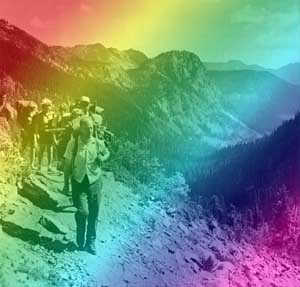 Ron and I
were first introduced to hiking by dad, who took us
on a hike to Snow Lake, located near Snoqualmie
Pass. For beginning equipment, I had a wooden pack
frame with a simple one-compartment pack attached.
The pack had no hip belt, so after a few miles it
felt very heavy indeed!
Ron and I
were first introduced to hiking by dad, who took us
on a hike to Snow Lake, located near Snoqualmie
Pass. For beginning equipment, I had a wooden pack
frame with a simple one-compartment pack attached.
The pack had no hip belt, so after a few miles it
felt very heavy indeed!
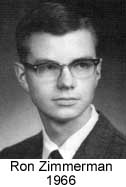 Over the years Ron and I
both improved our equipment. We purchased new
lightweight packs and lightweight sleeping bags. We
also bought heavy-duty hiking boots. I still own
and wear those same boots today. We also bought ice
axes, which went with us on all of our hikes. They
were great hiking sticks and came in handy not only
over snow and ice, but while crossing rushing
streams, muddy trails, and slippery logs.
Over the years Ron and I
both improved our equipment. We purchased new
lightweight packs and lightweight sleeping bags. We
also bought heavy-duty hiking boots. I still own
and wear those same boots today. We also bought ice
axes, which went with us on all of our hikes. They
were great hiking sticks and came in handy not only
over snow and ice, but while crossing rushing
streams, muddy trails, and slippery logs.
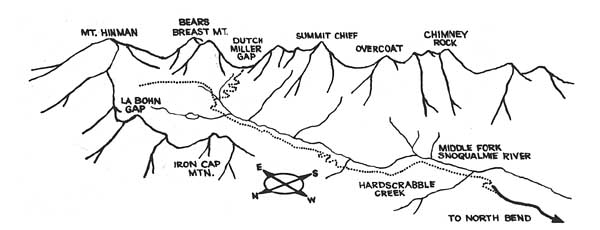
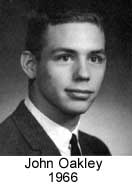
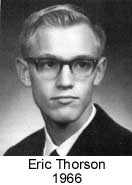 Of course, I
can't describe what transpired on the hike, but I
do remember the trip up to the trailhead. The road,
which followed the middle-fork of the Snoqualmie
River, was terrible! I remember driving up one
stretch. We had to drive across this huge tilted
slab of granite, which had been washed spotless by
a mountain stream. To the right was a drop-off into
a canyon 1000 feet below. To the other side was a
sheer cliff wall. There was barely room for the car
to drive, and with the slope towards the drop-off,
it was frightening to say the least!
Of course, I
can't describe what transpired on the hike, but I
do remember the trip up to the trailhead. The road,
which followed the middle-fork of the Snoqualmie
River, was terrible! I remember driving up one
stretch. We had to drive across this huge tilted
slab of granite, which had been washed spotless by
a mountain stream. To the right was a drop-off into
a canyon 1000 feet below. To the other side was a
sheer cliff wall. There was barely room for the car
to drive, and with the slope towards the drop-off,
it was frightening to say the least!
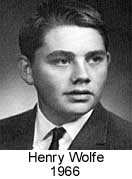 While
Ron was busy at Dutch Miller Gap, Henry Wolfe and I
went on a three-day hike to Lost Lake. The lake is
located just over Snoqualmie Pass near Cle Elum.
The advantage of this area is that it is in the
rain-shadow of the Snoqualmie Mountains. If it is
raining on the west side, it is often only
partly-cloudy in this area. Another advantage is
that there isn't a lot of under-brush to contend
with. Even if it is somewhat rainy, you don't get
as wet because you don't have to brush against so
much vegetation.
While
Ron was busy at Dutch Miller Gap, Henry Wolfe and I
went on a three-day hike to Lost Lake. The lake is
located just over Snoqualmie Pass near Cle Elum.
The advantage of this area is that it is in the
rain-shadow of the Snoqualmie Mountains. If it is
raining on the west side, it is often only
partly-cloudy in this area. Another advantage is
that there isn't a lot of under-brush to contend
with. Even if it is somewhat rainy, you don't get
as wet because you don't have to brush against so
much vegetation.
 The
hike from the end of the road was short, only about
three miles. When we arrived, we set up our camp by
putting a plastic sheet on the ground and
stretching another plastic sheet over us in a
lean-to fashion. We'd then made a nice campfire and
fixed dinner. The next day we hiked up to two other
lakes, Mirror Lake and Cottonwood Lake. On the way
up we encountered snow--enough snow to completely
cover the trail. We hiked out to the lakes, but
they were still iced over. It was too dangerous to
try to walk out on the lakes because spots had
started to thaw.
The
hike from the end of the road was short, only about
three miles. When we arrived, we set up our camp by
putting a plastic sheet on the ground and
stretching another plastic sheet over us in a
lean-to fashion. We'd then made a nice campfire and
fixed dinner. The next day we hiked up to two other
lakes, Mirror Lake and Cottonwood Lake. On the way
up we encountered snow--enough snow to completely
cover the trail. We hiked out to the lakes, but
they were still iced over. It was too dangerous to
try to walk out on the lakes because spots had
started to thaw.
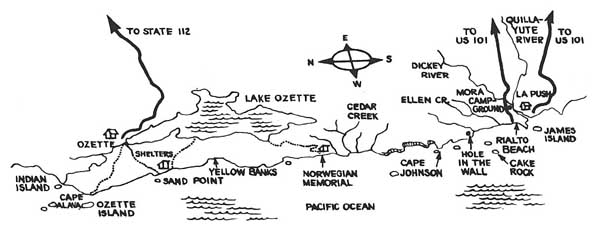
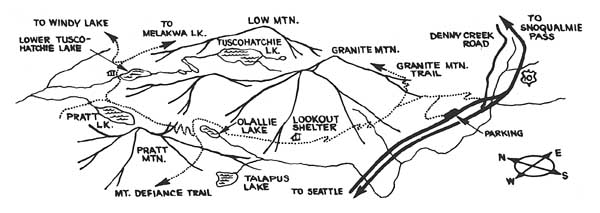
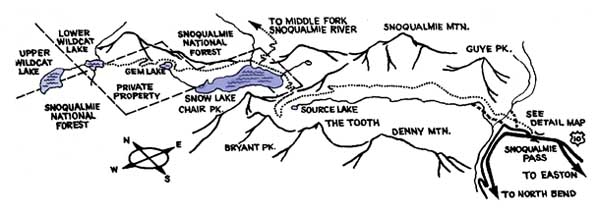
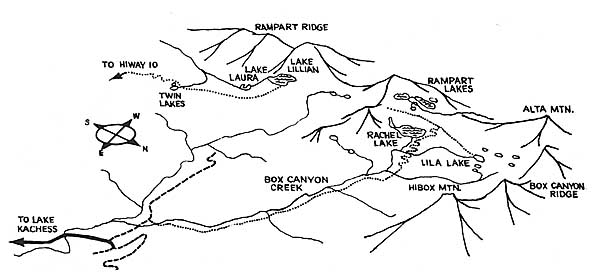
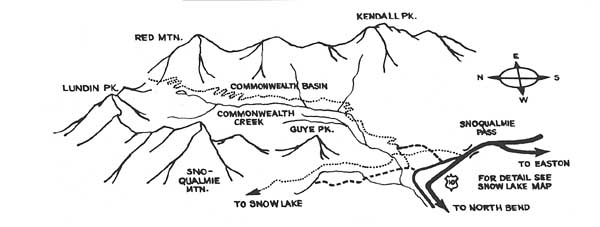
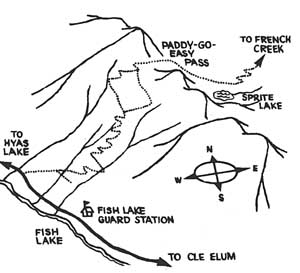
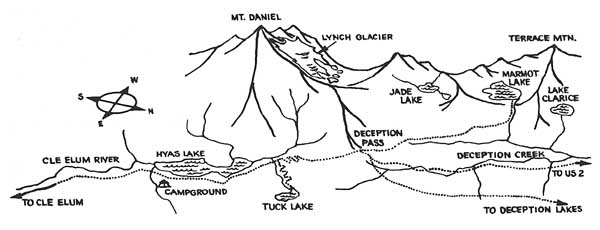
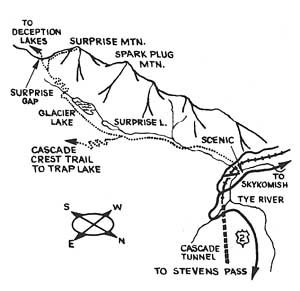
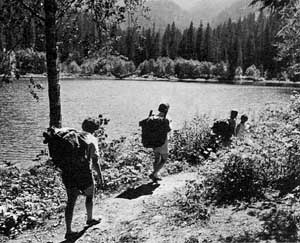
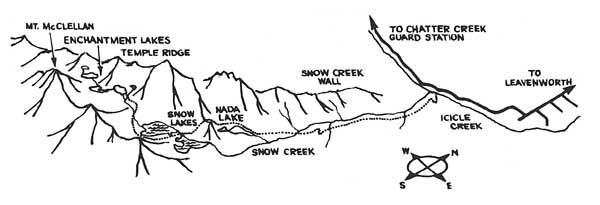
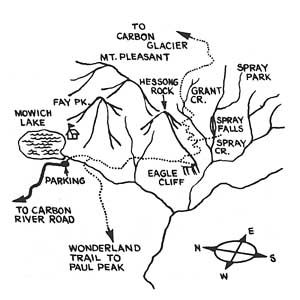
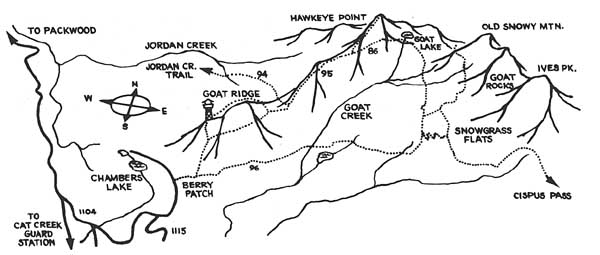
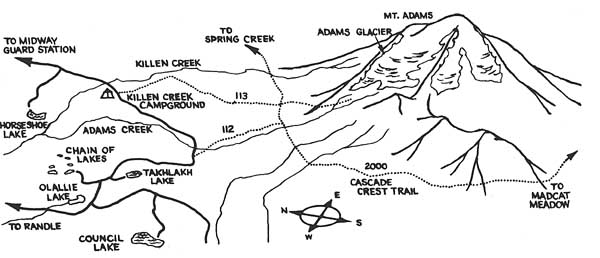
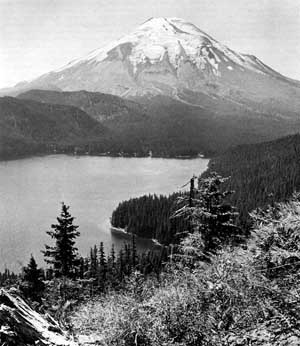
 While hiking across the summit
glacier, Roger Luce suddenly sunk one leg in the
"snow" up to his waist. He had stepped into the
narrow fissure of a crevasse! We spent an hour at
the top and then headed down. The wands were a
godsend, since it was really hard to locate the way
we had come up. It took us only two hours to get
back to camp since we could glissade on the
snowfields! This was a wonderful trip and memorable
because the mountain has since erupted, blowing off
the summit where we once stood.
While hiking across the summit
glacier, Roger Luce suddenly sunk one leg in the
"snow" up to his waist. He had stepped into the
narrow fissure of a crevasse! We spent an hour at
the top and then headed down. The wands were a
godsend, since it was really hard to locate the way
we had come up. It took us only two hours to get
back to camp since we could glissade on the
snowfields! This was a wonderful trip and memorable
because the mountain has since erupted, blowing off
the summit where we once stood.
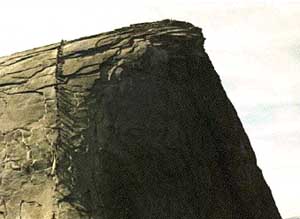
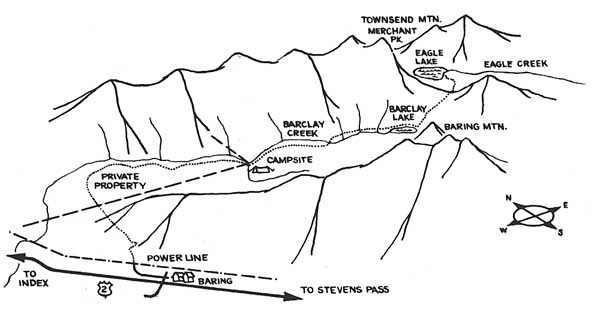
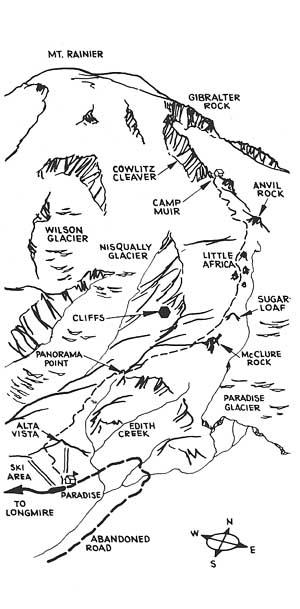
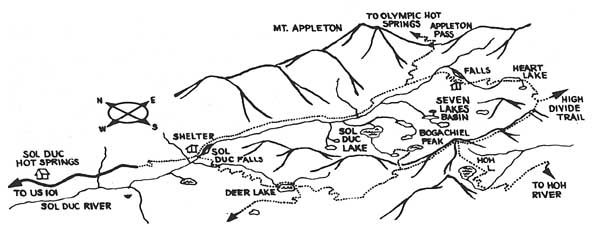
 Rick Larson and I drove to
the Olympic Peninsula to the start of the trail at
Sol Duc Hot Springs. We hiked for over eight hours
to a camp in the alpine meadows above Seven Lakes
Basin. The area is really wonderful, with many
small lakes and interesting hills to explore. We
arose early the next morning, made a breakfast of
oatmeal, wheat germ and applesauce, and then headed
around Bogachiel Peak and to the car at Sol Duc Hot
Springs. The trip was about twenty miles, and took
its toll in blisters on our feet. (By the way, we
made it home just in time to see Neil Armstrong
take the first step on the moon!)
Rick Larson and I drove to
the Olympic Peninsula to the start of the trail at
Sol Duc Hot Springs. We hiked for over eight hours
to a camp in the alpine meadows above Seven Lakes
Basin. The area is really wonderful, with many
small lakes and interesting hills to explore. We
arose early the next morning, made a breakfast of
oatmeal, wheat germ and applesauce, and then headed
around Bogachiel Peak and to the car at Sol Duc Hot
Springs. The trip was about twenty miles, and took
its toll in blisters on our feet. (By the way, we
made it home just in time to see Neil Armstrong
take the first step on the moon!)
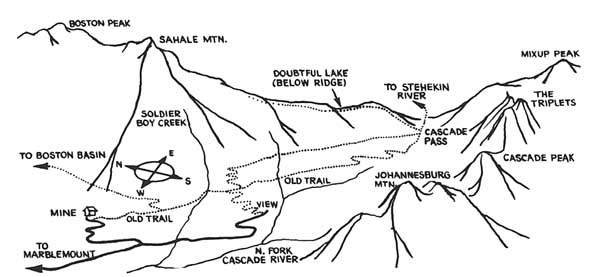
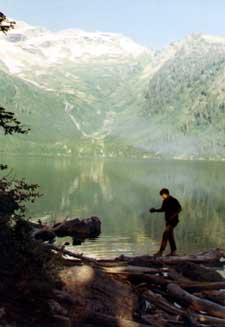 This was a memorable hike, mostly because
it was in the Rockies and also for the problems we
encountered. I went on this hike with Bob Davies, a
friend I met while visiting Harold Hamon in Great
Falls, Montana. Bob was an avid fisherman, and he
had heard that the fishing was fabulous at Sunburst
Lake. He talked Del Hamon and another friend,
George Kern, into coming with us. We left at 5 PM
and drive into the late evening hours. The road to
the trailhead was gravel, and Bob Davies apparently
didn't know the word "slow." We zoomed up the road
at 50 to 60 miles per hour, and paid dearly for it
when Bob realized he had a flat tire. And worse
yet, he had TWO flat tires! He only had one spare,
so we spent the night sleeping in the truck. The
next morning we started walking back, and were
fortunate to meet a logging truck with an air pump.
He inflated our tires and we zoomed back the other
way and made it to a Texaco service station before
they went flat again. We drove more slowly on the
return trip and arrived at the trailhead at 1:30.
We were eager to get to the lake, so we hiked like
mad up the trail trying to regain lost time. But,
as luck would have it, we took a wrong turn and
ended up hiking three miles up the wrong trail! We
finally got on the right trail and forded three
large streams on the way in. Just before dark,
Bob's dog scented a porcupine and ended up with
spines in his nose. Bob shot the porcupine with his
pistol and was fit to be tied when he realized that
we'd have to make camp in a meadow, short of our
destination.
This was a memorable hike, mostly because
it was in the Rockies and also for the problems we
encountered. I went on this hike with Bob Davies, a
friend I met while visiting Harold Hamon in Great
Falls, Montana. Bob was an avid fisherman, and he
had heard that the fishing was fabulous at Sunburst
Lake. He talked Del Hamon and another friend,
George Kern, into coming with us. We left at 5 PM
and drive into the late evening hours. The road to
the trailhead was gravel, and Bob Davies apparently
didn't know the word "slow." We zoomed up the road
at 50 to 60 miles per hour, and paid dearly for it
when Bob realized he had a flat tire. And worse
yet, he had TWO flat tires! He only had one spare,
so we spent the night sleeping in the truck. The
next morning we started walking back, and were
fortunate to meet a logging truck with an air pump.
He inflated our tires and we zoomed back the other
way and made it to a Texaco service station before
they went flat again. We drove more slowly on the
return trip and arrived at the trailhead at 1:30.
We were eager to get to the lake, so we hiked like
mad up the trail trying to regain lost time. But,
as luck would have it, we took a wrong turn and
ended up hiking three miles up the wrong trail! We
finally got on the right trail and forded three
large streams on the way in. Just before dark,
Bob's dog scented a porcupine and ended up with
spines in his nose. Bob shot the porcupine with his
pistol and was fit to be tied when he realized that
we'd have to make camp in a meadow, short of our
destination.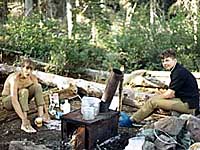
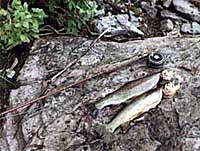 The
next morning we made it to the lake by 8:30 AM. Bob
Davies inflated a rubber raft and promptly caught
one 20-inch and one 17-inch cutthroat trout. I
caught a 17-incher as well, but released it. The
weather was wonderful, and we toyed with the idea
of staying several days. However, Del had promised
his dad that he'd help with church, so we hiked the
ten miles out in five hours. Got back to Great
Falls at 4:30 in the morning. Del's dad woke him at
6:30 and made his go to church. Boy was he ever
tired. I was glad to be able to sleep until 9:30.
The
next morning we made it to the lake by 8:30 AM. Bob
Davies inflated a rubber raft and promptly caught
one 20-inch and one 17-inch cutthroat trout. I
caught a 17-incher as well, but released it. The
weather was wonderful, and we toyed with the idea
of staying several days. However, Del had promised
his dad that he'd help with church, so we hiked the
ten miles out in five hours. Got back to Great
Falls at 4:30 in the morning. Del's dad woke him at
6:30 and made his go to church. Boy was he ever
tired. I was glad to be able to sleep until 9:30.
 At first
I went on several hikes with the Mountaineers. The
first was to Squak Mountain (May 24, 1969). The
pace was really slow, compared to what I was used
to, probably because there were a number of older
folks on the hike. The next day I went with another
group to Gobblers Nob (May 25, 1969). This was an
interesting hike, and ended up going across snow to
get to views of Mt. Rainier.
At first
I went on several hikes with the Mountaineers. The
first was to Squak Mountain (May 24, 1969). The
pace was really slow, compared to what I was used
to, probably because there were a number of older
folks on the hike. The next day I went with another
group to Gobblers Nob (May 25, 1969). This was an
interesting hike, and ended up going across snow to
get to views of Mt. Rainier.